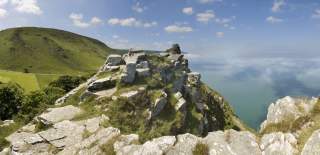Lynton & Lynmouth Victorian Heritage Itinerary
The twin towns of Lynton & Lynmouth on the North Devon coast have a fascinating and varied history dating back hundreds of years.
It is a history of change, from a rural coastal farming hamlet and fishing village, to enterprise and tourism. Yet despite development over the past two centuries, the towns have retained their attractive charm and character to this day. Depending on where you’re staying you may wish to visit these historic attractions in the reverse order.
Day 1
Spend the day meandering between the two towns of Lynton & Lynmouth and immerse yourself in their Victorian charm.
Begin your day with a brief stop at the Lynton Town Hall built by Sir George Newnes in the late 1800’s. Admire the detailed architecture of its exterior and wonderful carved interior. While you’re here, call in to the Tourist Information Centre and browse through a great selection of books about Lynton & Lynmouth’s historic past.
Whilst still in Lynton wander through the old town towards the Lynton & Lynmouth Museum. This is charmingly small museum is one of Lynton’s oldest buildings with collections of agricultural and domestic tools from Lynton and Exmoor’s past.
Time to leave Lynton and visit Lynmouth via the Lynton & Lynmouth Cliff Railway. This is the highest and steepest funicular railway in the world, and totally water-powered. This is a great opportunity to stop for refreshments in the Cliff Top Café and enjoy the spectacular views out over the Bristol Channel.
When you arrive in Lynmouth at the bottom of the Cliff Railway turn right and walk along the promenade towards the harbour. Check out the Rhenish Tower, the original was built in 1860 by General Rawdon to store salt water for indoor baths. It was later fitted with an electric light for use as a beacon. What you see today is a replica, rebuilt after the devastating flood of 1952.
The great flood of 1952 was the most devastating event in Lynmouth’s not-too-distant past. To see the extent of the damage and calamity caused by this flood, head to the Lynmouth Flood Memorial. This permanent exhibition includes a scale model of the village pre-flood, along with images of the buildings which were destroyed and how to identify their sites. There are many personal accounts, photos, as well as material on a recent theory that it may have been the result of cloud-seeding experiments by the military.
Walk along the East Lyn River and trace the original path of the East Lyn River and imagine Lynmouth as it was before the flood.
Day 2
Another day exploring the Victorian heritage of Lynton & Lynmouth.
Following yesterday’s visit to the Lynmouth Flood Memorial, head back to Lynmouth for a stroll. This time walk further along the East Lyn River towards Watersmeet. Along the way, you will see the remains of the old Lynrock Mineral Water Factory that was cruelly swept away by the powerful waters of the Lyn River. Look out for the old Ginger Beer bottle immortalised in the valley wall, near an old fireplace standing alone by the water’s edge.
If you walk as far as Watersmeet Lodge, you can enjoy tea and cakes in the beautiful gardens of this National Trust property.
Head back to Lynmouth and then to your car for a short drive out of the two towns to Woody Bay Railway Station and experience one of the last, great narrow-gauge railway adventures. At 964 feet above sea level, Woody Bay is the highest railway station in Southern England and home of the World's newest steam engine.
The original Lynton & Barnstaple Railway opened as an independent railway in May 1898. It was a single-track, narrow gauge railway and travelled just over 19 miles, running through the picturesque Exmoor landscape.
Head back to Lynton to complete your Victorian Heritage experience.
Want to experience a little more?
Take a short walk up Hollerday Hill to the site of the old Hollerday House. This once-imposing mansion was built in the 1890s by Sir George near the summit of Hollerday Hill, directly behind the Lynton Town Hall.
Sir George died here in June 1910 and in August 1913 the mansion was destroyed by fire. The remains of the house were demolished by the army during the Second World War and much of the stone re-used to build bridges and structures destroyed by the 1952 flood.
Hollerday Hill is a beautiful wooded hill with stunning views over the Bristol Channel and the Valley of Rocks. It’s the perfect place to conclude a wonderful stay in Lynton & Lynmouth.


